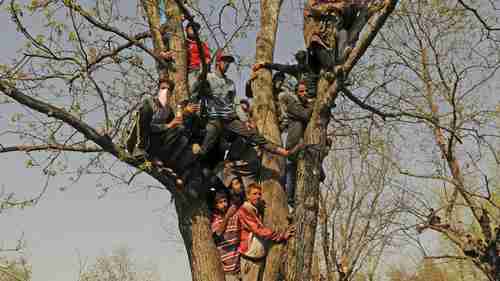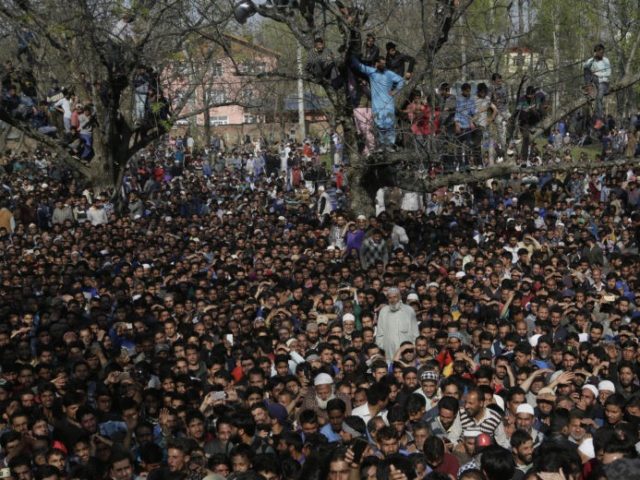This morning’s key headlines from GenerationalDynamics.com
- Massive new anti-India violence in Kashmir leads to 20 deaths
- Uprising in Kashmir continues to grow into war between India and Pakistan
Massive new anti-India violence in Kashmir leads to 20 deaths

Kashmiri villagers during a funeral at Shopian, South Kashmir, during the anti-Indian protests (Hindustan Times)
Sunday was one of the bloodiest days in Indian-controlled Kashmir in recent months, after a new generation of separatist Kashmiri youths led massive anti-India protests and violence in several parts of Indian-controlled Kashmir. Thousands of Kashmiris were in the streets chanting anti-India slogans and demanding an end to Indian rule over Kashmir. Some 20 people were killed, including 3 soldiers and 17 Kashmiris, with dozens more injured.
A spokesman for Hurriyat, a Kashmiri separatist organization, is calling for continued protests in the days to come:
The joint resistance leadership calls for a shutdown tomorrow against the killings and atrocities on people in south Kashmir. Hundreds have been injured in pellet and bullet firing.
Separatists are calling for strikes on Monday and Tuesday, and authorities have ordered all schools to be shut.
The protests and clashes were triggered by a series of counter-insurgency operations, based on tips to police about where militant separatists may be hiding. Many civilians living in Kashmir support these militants and demand that Indian-governed Kashmir be allowed to merge with Pakistan-governed Kashmir and become part of Pakistan.
In June 2017, India announced “Operation All-Out,” in which thousands of security forces were involved in a massive house-to-house sweep to “deliver a lethal blow to terrorism.” Operation All-Out went on for months and was responsible for killing over 200 militants, according to Indian authorities. The violence has already escalated in 2018, with 51 alleged militants already killed so far this year. Geo TV (Pakistan) and AFP and Hindustan Times and AP
Uprising in Kashmir continues to grow into war between India and Pakistan
As I’ve described several times in the past, from the point of view of Generational Dynamics, the growing violence in Kashmir is following a fairly standard historical template that always ends in a major war. I have written in the past to distinguish between “organic” genocides that come from the people, such as the 1994 Rwanda genocide, versus “government-led” genocides, such as occurring today in Syria and South Sudan.
Although there is little doubt that Pakistan-based groups are inciting violence in Kashmir, that is not enough to start a generational war unless the mood of the population is that such a war is necessary. What we are seeing in Kashmir is an “organic” war that is leading unstoppably to a generational crisis war.
As I described in the past, India’s last two generational crisis wars were India’s 1857 Rebellion and the 1947 Partition war.
The 1857 rebellion is also called India’s First War of Independence from the British colonial power. What started out as protests related to the Hindu veneration of cows grew into an extremely bloody generational crisis war, resulting in the deaths of over 100,000 Indian civilians.
India remained a British colony, and there was little or no violence for decades, as always happens after a generational crisis war, since the traumatized survivors do not wish anything so horrible to happen again. However, as younger generations with no personal memory of the war rise to power, conflicts begin again.
In the 1910s, Mahatma Gandhi, the Indian peace activist, launched a “non-cooperation movement” against the British involving civil disobedience. The generational Awakening era climax occurred on April 10-12, 1919, with the Jalianvala Bagh Massacre (Amritsar Massacre), when British troops opened fire on 10,000 Sikhs holding a protest meeting, killing hundreds. That event convinced both the British and the Indians that Britain should completely give up control of India.
By 1946, there was a debate centered on two choices: Should there be a single Indian state, with separate regions under the control of Muslims and Hindus, or should there be a two-state solution, a Muslim state living side-by-side in peace with a Hindu state? The argument that won the day was that Muslims cannot stand pigs and Hindus cannot eat cows, and so they cannot live together. Finally, British, Muslim and Hindu officials all agreed that there had to be two separate states, India and Pakistan. In particular, the 1857 rebellion was still in everyone’s mind, and it was hoped that the two-state solution would lead to peace.
There is an old saying that “History doesn’t repeat itself, but it rhymes.” In this case, the massive violence of the 1857 rebellion was repeated, but not between Indians and British. Instead, it was between Hindus and Muslims, and with the same ferocity.
In 1947, the Indian subcontinent was partitioned into two countries, India and Pakistan, and no sooner did that happen then there was a massive new generational crisis war. But with the British colonists gone, this war pitted the Hindus against Muslims, in one of the bloodiest wars of the 20th century.
Once again, there was relative peace following the war, but once again, younger generations have been rising, and have no fear of a new war. The accusation today that Pakistan-based groups are using social media to incite violence is undoubtedly true, but India media are no better.
Since the 1947 Partition war, there have been three non-crisis wars fought between India and Pakistan over Kashmir. Those wars fizzled, but now in a general Crisis era, all the participants – Pakistanis, Kashmiris, and Indians – are becoming increasingly nationalistic and xenophobic. As the protests and violence grow, this would spiral into a much larger war, just as the initial protests did in 1857 and 1947, and turn into a war between Pakistan and India, both nuclear powers.
Generational Dynamics predicts that the approaching Clash of Civilizations world war will pit China, Pakistan and the Sunni Muslim countries against the US, India, Russia, and Iran. In the Mideast, Generational Dynamics predicts a full-scale Mideast war, pitting Jews against Arabs, Sunnis against Shias, and various ethnic groups against each other. Benar News and Greater Kashmir
Related Articles
- India’s ‘Operation All-Out’ brings Kashmir closer to all-out war (24-Jun-2017)
- India’s Narendra Modi finally hits out at Cow Protectors (‘Gau Rakshaks’) (07-Aug-2016)
- China threatens military intervention in Kashmir on the side of Pakistan (12-Jul-2017)
- Kashmir violence surges as India launches massive house-to-house sweep (06-May-2017)
- Uprising in Kashmir growing into major regional war between India and Pakistan (01-Apr-2017)
KEYS: Generational Dynamics, India, Pakistan, Kashmir, Hurriyat, Operation All-Out, 1857 Rebellion, 1947 Partition War, Mahatma Gandhi, Jalianvala Bagh Massacre, Amritsar Massacre
Permanent web link to this article
Receive daily World View columns by e-mail

COMMENTS
Please let us know if you're having issues with commenting.